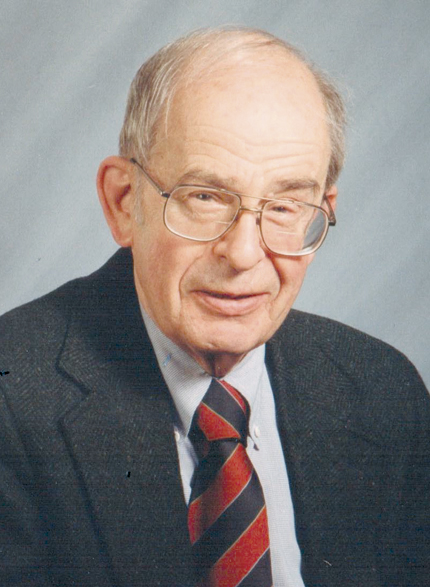Gert Ehrlich
DOI: 10.1063/PT.3.2091
Gert Ehrlich, who made important contributions to surface science, especially in the area of atomic interactions on solid surfaces, died of leukemia on 10 August 2012 in Urbana, Illinois. Up to five weeks before his death, he worked tirelessly as a professor in the materials science department at the University of Illinois at Urbana-Champaign. He coauthored more than 200 scientific articles and the book Surface Diffusion: Metals, Metal Atoms, and Clusters (Cambridge University Press, 2010).
Gert was born on 22 June 1926 in Vienna. After Germany annexed Austria in 1938, Gert and his father, who was Jewish (his mother was Catholic), were detained for questioning but, luckily, released. His father immediately departed for the US, and in May 1939 Gert and his sister, Dorothy, arrived unescorted in New York on the T.S.S. Veendam and were reunited with their father. What might have been a harrowing voyage had become a grand adventure: Gert had investigated all aspects of the ship’s operation and explored the ship from top to bottom. His mother joined the family several months later.
In 1944 Gert enrolled at Columbia University. He served in the US Army from 1945 to 1947 and then returned to graduate from the university with honors in chemistry in 1948. He obtained his PhD in chemistry from Harvard University in 1952 under adviser Paul Doty; his thesis title was “Studies on synthetic polyampholytes.” Gert remained at Harvard for a year as a National Institutes of Health fellow. He then served a year as a research associate in the University of Michigan physics department, where he worked with Gordon Sutherland on IR spectroscopy of macromolecules.
In 1953 Gert accepted a full-time appointment at the General Electric Research Laboratory in Schenectady, New York, where he studied the kinetics of gas–solid interactions. He developed temperature-programmed, or flash, desorption techniques for quantitative kinetic studies at the gas–solid interface and demonstrated the importance of distinct binding sites in chemisorption phenomena.
The field ion microscope, invented in 1951 by Erwin Müller, enabled Gert to probe the underlying atomic details of his macroscopic observations. Gert made unique chemisorption studies on single-crystal surfaces and the first quantitative observations of individual atoms diffusing on a metal surface. His resulting 1966 article with Frank Hudda in the Journal of Chemical Physics has been cited more than 1000 times.
Gert accepted a professorship at the University of Illinois in 1968. Leading a small group of graduate students and postdocs, he expanded his research toward surface studies on an atomic scale. Using an atom-probe field ion microscope, Gert and his group made the first direct observation of an adatom exchange mechanism. They observed and characterized numerous aspects of surface diffusion, including interior step-edge barriers, reflective plane-edge barriers, adatom–vacancy interactions, temperature-dependent long jumps, and adatom cluster motion. Gert and his group used a variety of theoretical and experimental methods to study atomic behavior and transformed the apparently hopelessly complicated subject of surface diffusion at the atomic scale into one much more understandable and explainable.
Among the several honors Gert received were the 1979 Medard W. Welch Award from the American Vacuum Society and the 1982 American Chemical Society Award in Colloid and Surface Chemistry. Through a 1992 research award from the German Alexander von Humboldt Foundation, he worked on boundary layer chemistry and interfacial chemistry at the Fritz Haber Institute in Berlin with Gerhard Ertl and Jochen Block.
Gert was an extremely careful and extraordinarily attentive researcher, with the highest achievable vacuum and precise timing and temperature controls. Gert also was merciless in the proper statistical analysis of data—no small task in the early slide-rule days when access to a computer meant a time-sharing connection on a teletype at 10 characters per second.
Perhaps Gert’s most endearing characteristic was his concern for students. His door was always open. When a student would stop by with a question, Gert usually answered with another question to challenge the student. He established a mentoring system in which current students taught the necessary know-how and unpublished techniques to incoming students. When not in the lab, he could easily be found: As he wandered the halls, he would produce a low, enigmatic, warbling whistle, usually his unique rendering of a classical opera aria.
Gert was a curious scientist, and his precise work on the behavior of atoms on surfaces was foundational to modern nanoscience and technology. He also was an excellent teacher who compulsively prepared every lecture, even on material he had previously taught. On receiving news about the success of a former student, he would sport a generous grin and his eyes would sparkle.

Gert Ehrlich

More about the Authors
Grazyna Antczak. Wrocław, Poland.
Robert S. Chambers. Champaign, Illinois.
Armin Gölzhäuser. Bielefeld, Germany.
